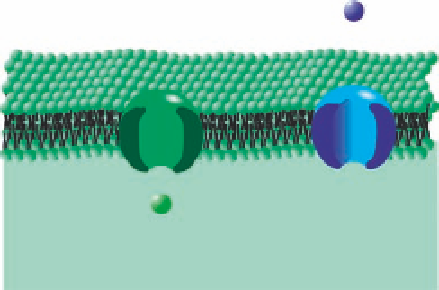Biomedical Engineering Reference
In-Depth Information
4.
The remaining 20 percent of the carbon dioxide in the red blood cell combines with
hemoglobin to form carbaminohemoglobin. This is a weak bond that is easily broken:
Hb
þ
CO
!
HbCO
2
2
After the red blood cell reaches the lungs, the oxygen that diffused across the alveoli
membrane displaces the carbon dioxide in the blood and binds with the hemoglobin. Car-
bon dioxide then diffuses through the alveoli membrane and is then exhaled. The entire
process then repeats itself.
8.4.2 Diffusion and Enzyme Kinetics
Consider the movement of a substrate into a cell by diffusion, which then reacts with
an enzyme to ultimately form a product that leaves the cell by diffusion, as shown in Fig-
ure 8.19. The chemical reaction is
ð
8
:
75
Þ
and diffusion by
q
S
i
¼
B
oi
q
S
o
B
io
q
S
i
q
P
i
¼
D
oi
q
P
o
D
io
q
P
i
ð
8
:
76
Þ
where
B
oi
,
B
io
,
D
oi
, and
are the diffusion transfer rates. The equations describing the
D
io
complete system are
q
S
i
¼
K
1
q
S
i
q
E
þ
K
1
q
ES
i
þ
B
oi
q
S
o
B
io
q
S
i
q
ES
i
¼
K
1
q
S
i
q
E
K
1
þ
K
2
ð
Þ
q
ES
i
ð
8
:
77
Þ
q
P
i
¼
K
q
ES
i
þ
D
oi
q
P
o
D
io
q
P
i
2
P
o
S
o
Outside
D
oi
D
io
B
oi
B
io
Inside
S
i
P
i
K
1
K
-1
®
K
2
®
S
i
+
E
ES
i
E
+
P
i
FIGURE 8.19
Diffusion and enzyme kinetics.








































